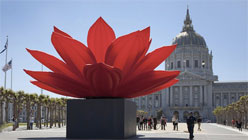The San Francisco Asian Art Museum’s Phantoms of Asia: Contemporary Awakens the Past is a neat twist on the traditional notion that contemporary art is influenced or inspired by whatever has preceded it. Featuring 60 pieces by 31 contemporary artists, as well as 90 objects from the museum’s collection, the exhibition, which was curated by Mami Kataoka of Tokyo’s Mori Art Museum and Allison Harding of the AAM, fills the museum’s entire first floor, as well as nooks and crannies on its second and third, juxtaposing old with new in the hopes that the latter will inform our experience of the former.
It mostly works, in no small part because ancient objects appear aloof to most contemporary eyes — they generally need all the mediation they can get. Equally musty are the exhibition’s lofty subjects, from Korean, Japanese, Chinese and other Asian cosmologies to meditations on the afterlife and the region’s countless deities. “Where did we come from? Where are we going?” asks Kataoka in the first two lines of her catalog essay. Good grief, this is going to be heavy slogging. But for the most part, the contemporary work on view serves its purpose of easing our eschatological load, infusing the sometimes somber galleries with light and color.

Poklong Anading, Anonymity, 2008-2011.
Sometimes the light is blinding, as in the photographs of Filipino artist Poklong Anading, whose nine pieces from his Anonymity series resemble bland portraits, except for the searing light that seems to emit from the face of each subject. In fact, the people in Anading’s pictures are each holding a mirror in front of them, thus using light not to illuminate but to obscure. Cleverly, the curators have paired these photos with ancient Chinese bronze mirrors, which are decorated on one side with depictions of the cosmos and were buried with the dead, as if to help them find their way on the other side. Anading gets us thinking about all this, mostly because his work is so deliberately unhelpful.

The Hindu god Shiva slaying the elephant demon, from approximately 1850.



